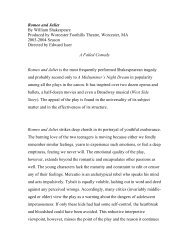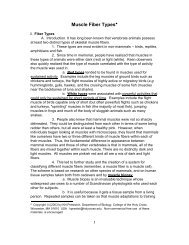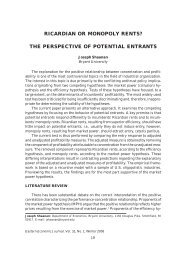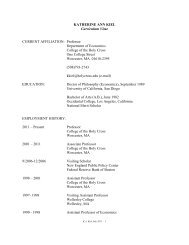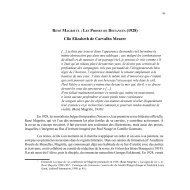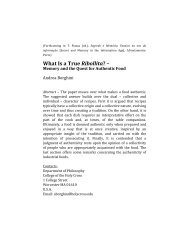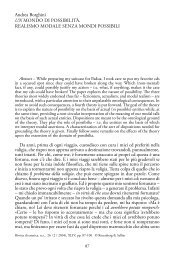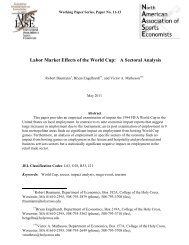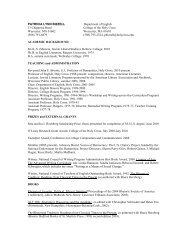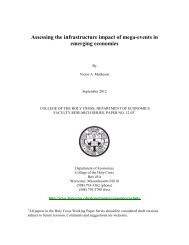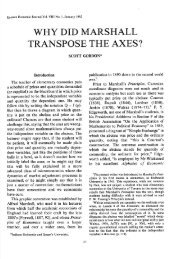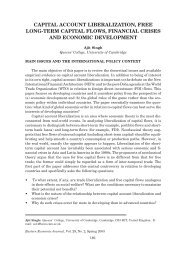club objectives and ticket pricing in professional team sports
club objectives and ticket pricing in professional team sports
club objectives and ticket pricing in professional team sports
Create successful ePaper yourself
Turn your PDF publications into a flip-book with our unique Google optimized e-Paper software.
550<br />
EASTERN ECONOMIC JOURNAL<br />
Szymanski, 2002]. Kesenne [1996, 2000] <strong>and</strong> Ford <strong>and</strong> Quirk [2004] show that, under<br />
the w<strong>in</strong> maximization hypothesis, the dem<strong>and</strong> for talent <strong>and</strong> the <strong>ticket</strong> price are higher,<br />
lead<strong>in</strong>g to a worse competitive balance. Beside dem<strong>and</strong> for talent <strong>and</strong> competitive<br />
balance, also gate <strong>ticket</strong> <strong>pric<strong>in</strong>g</strong> has been studied. Noll [1974], Heilmann <strong>and</strong> Wendl<strong>in</strong>g<br />
[1976], Scully [1989] <strong>and</strong> Salant [1992], among others, analyzed the optimum <strong>pric<strong>in</strong>g</strong><br />
strategies of profit maximiz<strong>in</strong>g owners, <strong>in</strong>clud<strong>in</strong>g several revenue sources <strong>and</strong> add<strong>in</strong>g<br />
stadium capacity restrictions. All found <strong>ticket</strong> prices that are set <strong>in</strong> the <strong>in</strong>elastic range<br />
of the dem<strong>and</strong> curve. In a recently published article, Fort [2004] explores these empirical<br />
f<strong>in</strong>d<strong>in</strong>gs <strong>and</strong> shows the logic for <strong>in</strong>elastic gate <strong>pric<strong>in</strong>g</strong>.<br />
To the best of our knowledge, all these studies start from models with only one<br />
decision variable, talent dem<strong>and</strong> or <strong>ticket</strong> price, keep<strong>in</strong>g the other variable constant.<br />
Our contribution to this literature is that we start from a model with two decision<br />
variables: talent dem<strong>and</strong> <strong>and</strong> <strong>ticket</strong> price, under both the profit <strong>and</strong> the w<strong>in</strong> maximization<br />
hypothesis. We assume that <strong>team</strong> managers have to decide simultaneously, at<br />
the start of the season, how many talents they will hire <strong>and</strong> what <strong>ticket</strong> price they will<br />
charge. It is obvious that the <strong>ticket</strong> price affects revenue <strong>and</strong> that the <strong>club</strong> budget<br />
affects the talents they can afford <strong>and</strong>, vice versa: that the number of talents affect<br />
<strong>ticket</strong> dem<strong>and</strong> <strong>and</strong> <strong>ticket</strong> price. This approach challenges a few well-known conclusions<br />
from economic research such as, ‘a stadium capacity constra<strong>in</strong>t results <strong>in</strong> a<br />
higher optimal <strong>ticket</strong> price’ or ‘higher players salaries do not affect the optimal <strong>ticket</strong><br />
price if the marg<strong>in</strong>al cost of spectators is zero’, as well as the impact of some market<br />
regulations, such as impos<strong>in</strong>g salary caps.<br />
In what follows, we start with the comparison of the profit <strong>and</strong> the w<strong>in</strong> maximiz<strong>in</strong>g<br />
hypothesis <strong>in</strong> a model that takes <strong>in</strong>to account the simultaneous management<br />
decisions on <strong>ticket</strong> price <strong>and</strong> talent dem<strong>and</strong>. This is done <strong>in</strong> the second section. The<br />
next section analyses the impact of a stadium capacity restriction on <strong>ticket</strong> price <strong>and</strong><br />
talent dem<strong>and</strong>. In the follow<strong>in</strong>g section, policy implications such as impos<strong>in</strong>g maximum<br />
<strong>ticket</strong> prices, impos<strong>in</strong>g salary caps <strong>and</strong> grant<strong>in</strong>g a government subsidy are considered.<br />
The last section concludes.<br />
THE PROFIT VERSUS THE WIN MAXIMIZATION HYPOTHESIS<br />
In this section we develop a model of <strong>professional</strong> <strong>team</strong> <strong>sports</strong> compar<strong>in</strong>g both<br />
optimal <strong>ticket</strong> prices <strong>and</strong> talent dem<strong>and</strong> <strong>in</strong> the profit <strong>and</strong> the w<strong>in</strong> maximization scenario.<br />
After specify<strong>in</strong>g the model, we <strong>in</strong>troduce profit <strong>and</strong> w<strong>in</strong> maximization <strong>and</strong> compare<br />
the outcomes, us<strong>in</strong>g some clarify<strong>in</strong>g graphical presentations. A comparative statics<br />
analysis allows us to derive the impact of the salary level <strong>and</strong> the size of the<br />
market.<br />
Maximiz<strong>in</strong>g the w<strong>in</strong>n<strong>in</strong>g percentage of a <strong>team</strong>, as a special case of utility maximization,<br />
is a rather specific but not unrealistic objective for <strong>professional</strong> <strong>sports</strong> <strong>club</strong>s. It<br />
should be clear that the w<strong>in</strong> maximization model does not completely disregard profits<br />
or losses. Only, profits are not maximized <strong>in</strong> this approach, because <strong>club</strong>s have also<br />
other <strong>objectives</strong> such as w<strong>in</strong>n<strong>in</strong>g. If we assume a <strong>club</strong> to be ma<strong>in</strong>ly <strong>in</strong>terested <strong>in</strong><br />
sportive success, which means try<strong>in</strong>g to w<strong>in</strong> the championship or as many games as<br />
possible, the only way to reach that goal is to hire as much play<strong>in</strong>g talent as possible,



